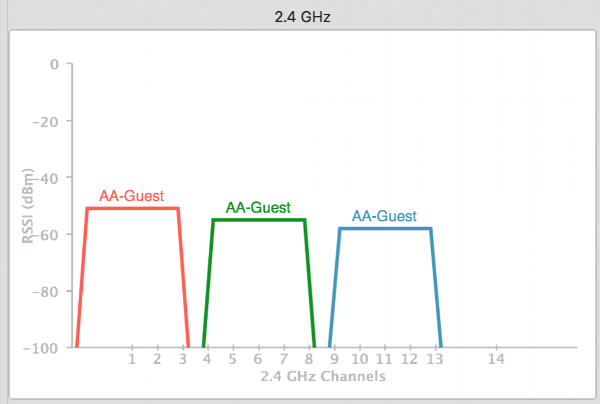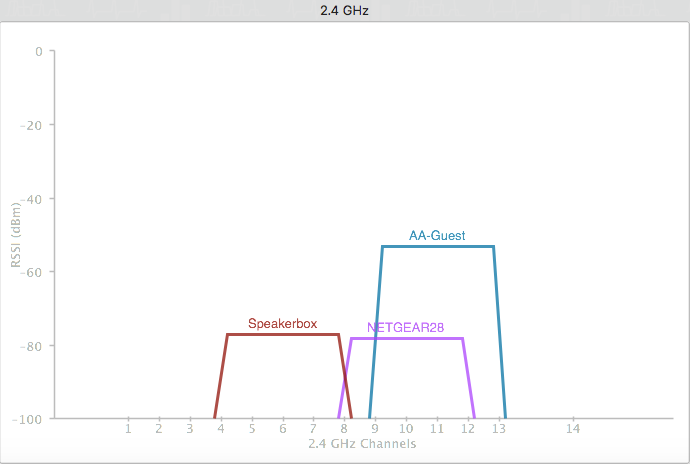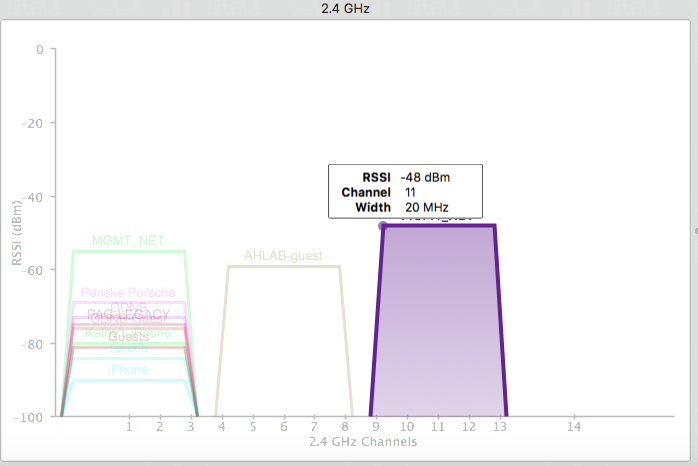Short Answer: Only use channel 1, 6, or 11.
View Your WiFi Environment with Mac or Windows WiFi Scanner
Download our Best WiFi Channel Quick Guide
Longer Answer: In the United States, while channels 1-13 can be used for 2.4 GHz WiFi, only three channels are considered non-overlapping (channels 12 and 13 are allowed under low powered conditions, but for most cases are not used). For best results, it is highly recommended to keep the 2.4 GHz channels to 1, 6, and 11, as these channel settings will allow for virtually no overlap in the WiFi signal. Shown below is a channel graph from WiFi Scanner showing three access points configured for channels 1, 6, and 11. As you can see, the center of each signal is at 1, 6, and 11 with the actual signal extending over several channels to the left and right.

An analogy for this behavior is shown in the graphic below of people standing next to each other in an exercise class. Each person needs enough room on either side to move freely and to fully extend their arms and legs when exercising. If a person stands in any position between 1 and 6 or 6 and 11, they will interfere with their neighbor on both sides.

For 2.4 GHz WiFi, only three out of the 13 channels should be used. Even though channels may look open for access points to use, the overlap caused by adjacent access points will degrade performance.
An example of an overlapping channel plan is below. The three access points are configured for channel 6, 10, and 11 (center of each graph). The channel 10 access point is overlapping the channel 6 and 11 access point.

The above examples are for single wide channels (20 MHz). It is also possible for access points to be configured for double wide channels (40 MHz). In this case, the access point configured for channel 1, +1 is overlapping with channel 6 access points.

It is very common in shared buildings and dense residential areas to have numerous access points on each non-overlapping channel. If all three non-overlapping channels are unavailable, the best option is to select the least crowded channel out of 1, 6, or 11 and run a speed test to see which one provides the best performance.

There are several other factors, such as non 802.11/WiFi interference and channel utilization, that should be considered when selecting between channel 1, 6 or 11. Below is a 2.4 GHz frequency spectrum graph that shows the magnitude of radio signals in the same frequency range used by 2.4 GHz WiFi. This information can be used to select channel 1, 6, or 11 based on the least amount of activity and lowest amplitude in the spectrum graph. In the following spectrum graph, channel 6 looks to have the lower amplitude and density of activity.


